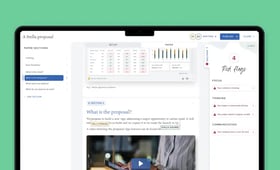Executive summary
Executive Committee (ExCo) members often tell us that they’d like their boards to make decisions more quickly, so that they can move forward with their plans at pace. And yet, board members tell us that they’re slowed down in their decision-making by bloated board papers.
How can boards and ExCos bridge that gap? In this guide, we explore:
-
Why writers produce bloated board papers in the first place, and the importance of the briefing process.
-
How ExCo members can encourage their team to write shorter papers.
-
The bigger-picture benefits of writing shorter papers, on company agility, team morale, and the ExCo’s reputation.
Why do we write bloated papers?
There are several myths about short board papers than encourage people to write long ones. They are:
- Short papers mean board members will miss out on important information.
- Long papers are the best way to demonstrate your knowledge of the subject.
- It's the writer's responsibility to make sure their paper hits the mark.
- The ExCo sponsor has better things to do than spend time with their team scoping the paper.
Addressing these misconceptions is the first step to tackling bloated papers, and saving time for board members, management, and governance teams.
Myth 1: Shorter papers lead to omissions or blind spots, and board members won’t get the information that they need.
If you give those writing the papers a clear brief from the outset, they'll be able to cover their bases concisely without drowning the reader (or themselves) in detail.
"There seems to be a fear of missing something out which leads to an avalanche of information in the report." - Paul Lester CBE, Chair, McCarthy Stone
Myth 2: Long papers demonstrate that you know enough about a subject to write profusely about it.
Short papers demonstrate that you understand the subject well enough to write about it concisely. If you can't simplify the key points for the readers and highlight what's important for them, you don't knowyour subject well enough.
"People often misunderstand how much information senior leaders need to make an effective decision. Huge narratives don't help the board, we just need to know what is the ask and why." - Guy Dunlop, General Counsel, TSB Bank
Myth 3: Shorter, sharper papers are the responsibility of the paper writer.
Shorter, sharper papers are the responsibility of the ExCo member sponsoring each paper, not the person or team holding the pen.
"As executive leaders, we should own the thought process behind our papers, and think, ‘What do I need to be sharing with the board in this document?’ We get back the quality of papers we deserve.” - John Tonkiss, CEO, McCarthy Stone
Myth 4: The ExCo sponsor doesn’t have time to shape the paper from the beginning.
By investing this time upfront, the ExCo can make sure the paper hits the mark the first time, control the narrative surrounding this paper, and keep the conversation on track in the boardroom.
“Earlier in my career, I allowed others to unduly influence the content of my board papers. This led to discussions on topics that I didn’t consider to be priorities.” - Juliette Tuakli, CEO, CHILD Accra
What does the research tell us?
In 2021, we surveyed 250 C-suite leaders in organisations with over £100m turnover to gather their views on board papers, the board reporting process, and their board's productivity. We also analysed submissions to our board reporting self-assessment tool, which assesses the strengths and weaknesses of board packs and papers.
This research found that shorter papers drive more impactful boardroom conversations.
-
Those with shorter board packs were, on average, more satisfied with the impact of their reports.
-
C-suite leaders themselves said that clearer reporting was one of the top three things that would help them move more quickly.
Yet, the majority of those involved in the reviewing process said their reports are lengthy and unclear.
-
Over half agreed that finding the key messages in their board packs was like finding a needle in a haystack.
-
56% said that their board papers weren't helping them have focused conversations.
The problem, and solution, is how we communicate with report writers.
-
57% of respondents think report writers don’t receive a clear brief beyond the paper title and deadline.
Shorter papers leave a lot more time for action, and the board can get straight to the decision-making.”
Paul Lester CBE, Chair, McCarthy Stone
How can the ExCo encourage shorter, sharper papers?
There are two key actions ExCo members can take to encourage their teams to write more concise and impactful board papers.
Part 1: The briefing process
To ensure a focused, efficient, and high-impact paper, you need a focused, efficient, and high-impact briefing process.
-
Decide the aim of the paper: Set aside time with your chair to agree on the brief. What’s the aim of the paper and what does it ask of the board? For example, is this a performance report, for the board’s information, or is it a decision paper, for board’s input? Making this clear to the writers will focus their thinking and therefore their writing.
-
Define the remit: How much should this paper cover? Consider what’s been mentioned elsewhere in the board pack as well as in previous committees and conversations.
-
Draft your questions: The above steps will help you define which questions this paper should address. We recommend that you keep these to a maximum of five. Any more will lead to information overload.
-
Test these questions: Do these questions lend themselves to concise answers? Do they prompt answers that don’t overlap with one another?
-
Allow for dialogue: Let your paper writers come back to you with questions before they start writing.
Using a question-and-answer format when briefing allows the report writers to be structured in their thinking, and to break down their thoughts into bite-sized chunks.”
Rachel Turk, Group Head of Strategy, Beazley
Part 2: The reviewing checklist
Once you've got your first draft back from the writer, check for the following:
-
Does the executive summary fit on one page? Your executive summary is not a lengthy introduction. It’s a snapshot of the paper and should fit on one side of A4.
-
What's the ratio of information to insight? Has the writer pulled out the “So what?” from the information presented or just included reams of data, expecting the readers to extract the insights themselves?
-
Is the writing straightforward? Has the writer avoided unnecessary technical jargon and flowery language? Do the sentences stick to a maximum of three lines? Will your board be able to understand the paper without seeking clarification?
-
Is the structure digestible? Can you grasp the key concepts of the paper at a glance? Has the writer used your questions as headings and, if needed, added subheadings to unpack smaller ideas?
-
Has the writer avoided repetition? Is each section mutually exclusive with others or does the content overlap? Could any similar ideas be grouped?
Shakespeare is great, but I don’t want him in my board reports.”
Royston Hoggarth, Chair, Innovation Group UK
How will shorter papers benefit the ExCo?
The benefits of shorter papers are extensive, especially for members of the ExCo.
-
You take control of the narrative. By making time to reflect on the contents of the paper from the beginning, you get to steer the boardroom conversation that follows on from it. As Dineshi Ramesh from Board Intelligence puts it: "You have the power to reframe your conversation with the board and improve their perception of you tenfold. How? By telling them what they want to know first; then what they didn’t even know they needed to know. That’s when you’re flying and in charge.”
-
You help your business to move faster. A short paper that answers the key questions makes it easier for the board to engage with the issue, and for the chair to navigate a meaningful discussion. You’re more likely to get your decision through the first time, and the organisation can move with momentum. As experienced chair Paul Lester told us: “Shorter papers will help the board to get aligned and supportive of your plan. Being an ExCo member can be a lonely job, so walking out of a meeting and feeling that the board is 100% behind you is a good position to be in.”
-
You use your team members' time wisely and keep them motivated. No more wasted hours trying to understand or improve reports that don’t quite hit the mark or lead to any tangible outcomes. As Rachel Turk from Beazley told us, “If you give the board a paper that’s pithy, the feedback will be positive, the impact will be clearer, and you’ll improve the morale of everyone involved.”
-
You shine in front of the board. You’ve given the board members a concise paper that tells them everything they need to know — nothing more and nothing less. What’s more, you show them that you’re a sharp, critical thinker who runs an excellent team. John Tonkiss, CEO of McCarthy Stone, described it like this: “If I get a brief, clear, and focused paper from a colleague, my impression of them will go up three notches, and so will the board’s.”
How can Board Intelligence help?
We’ve spent two decades working with FTSE 100 and Fortune 100 boards on their board papers. The result? The Question Driven Insight (QDI) Principle, a methodology for clear, concise, and compelling board papers, and an AI-powered report writing platform, Report Writer, that helps put it into practice.
Think board decks that pack a punch. Quarterly business reviews that build clarity and confidence. Investment proposals that are rock solid and green-lit fast. And all in much quicker time. Every time.
Book a demo to see it in action or to speak to one of our board reporting experts.
Our board pack was between 400–500 pages; it’s now down to around 150–200.
What’s more, our forward agenda is lighter and more focused. Most importantly, these leaner practices enable swifter decision making — because our boardroom conversations get straight to the areas we need to look at.”
Guy Dunlop, General Counsel,TSB Bank
With Report Writer, you can go from blank page to ready-to-share paper in a blink, with the help of AI built on 20 years of report writing expertise.
See report writerContributors
Paul Lester CBE
Paul is the chair of FTSE 250 company Essentra and PE-backed company McCarthy Stone. Previously, Paul was group managing director of Balfour Beatty and CEO of VT Group.
John Tonkiss
John is CEO of McCarthy Stone. Before this, John was chief executive of Human Recognition Systems and COO of Unit Group.
Rachel Turk
Rachel is group head of strategy at Beazley and board member of the Lloyd’s Market Association.
Guy Dunlop
Guy is general counsel at TSB. Before this, Guy was general counsel & executive director at Prudential.
Keith Hawkins
Keith is head of company secretariat at TSB Bank. Previously, Keith was a director in the corporate secretarial services department at EY
Juliette Tuakli
Juliette is CEO at medical clinic CHILD Accra, NED at Zenith Bank, and chair at United Way Worldwide
Royston Hoggarth
Royston is a former CEO and holds a portfolio of chair roles, including England Hockey, Innovation Group, Cirrus, Stellar Omada, and Intercede.
Anna Humphreys
Anna is a manager within Board Intelligence’s advisory team. Anna helps our clients solve most pressing problems in the boardroom, starting with their board packs.
Dineshi Rameshi
Indika is a director at Board Intelligence and leads our specialist delivery practice, advising boards and executive teams on how to improve the quality of their board meetings.



